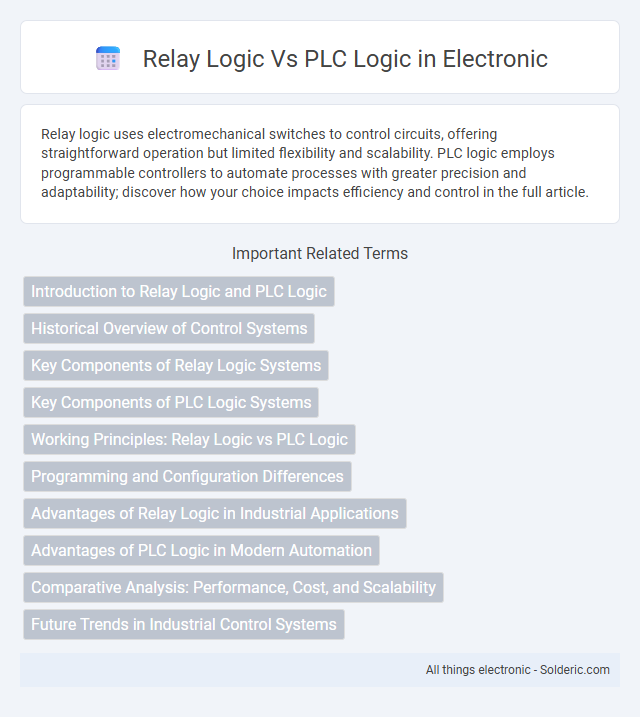Relay logic uses electromechanical switches to control circuits, offering straightforward operation but limited flexibility and scalability. PLC logic employs programmable controllers to automate processes with greater precision and adaptability; discover how your choice impacts efficiency and control in the full article.
Comparison Table
| Feature | Relay Logic | PLC Logic |
|---|---|---|
| Definition | Electromechanical switching using relays | Programmable controller using software logic |
| Components | Relays, contacts, coils, timers | CPU, memory, input/output modules |
| Flexibility | Fixed wiring, difficult to modify | Easily reprogrammed and updated |
| Speed | Slower, mechanical switching time | Faster, electronic processing |
| Maintenance | High, physical wear on relays | Low, mainly software troubleshooting |
| Size | Bulky due to multiple relays | Compact, integrated system |
| Cost | Initially low, increases with complexity | Higher initial cost, lower long-term cost |
| Reliability | Lower due to mechanical parts | Higher reliability with solid-state hardware |
| Programming | Hardwired logic | Ladder logic, function blocks, structured text |
Introduction to Relay Logic and PLC Logic
Relay logic uses electromechanical switches to control circuits through physical wiring, making it suitable for simple, low-speed applications with limited automation. Programmable Logic Controllers (PLCs) utilize digital microprocessors to execute complex control programs, offering flexibility, easy modification, and integration with industrial networks. PLC logic enables advanced processes such as real-time monitoring, data collection, and remote control, surpassing the capabilities of traditional relay systems.
Historical Overview of Control Systems
Relay logic, developed in the early 20th century, formed the foundation of industrial control systems through electromechanical switches to perform logical operations. PLC logic emerged in the late 1960s, revolutionizing automation by replacing physical relays with programmable software, enhancing flexibility and reliability. Understanding your control system's evolution from relay to PLC logic highlights the shift from hardware-dependent configurations to versatile, software-driven automation solutions.
Key Components of Relay Logic Systems
Relay logic systems primarily consist of electromechanical relays, timers, and switches that control electrical circuits through physical contacts. These components work together to implement sequential operations by opening and closing circuits based on input conditions without the need for programming. Your understanding of relay logic's tangible hardware can help differentiate it from the software-driven programming found in PLC logic systems.
Key Components of PLC Logic Systems
PLC logic systems rely on essential components such as the central processing unit (CPU), input/output (I/O) modules, and memory units to execute programmed instructions. The CPU processes input signals from sensors through I/O modules, then controls actuators based on stored logic sequences within the memory. This structure provides greater flexibility, faster processing, and easier modifications compared to traditional relay logic systems.
Working Principles: Relay Logic vs PLC Logic
Relay logic operates through electromechanical switches and physical contacts that open or close circuits based on input conditions, relying on hardwired connections for control. PLC logic uses programmable microprocessors to execute instructions and control outputs digitally, allowing for flexible and complex automation sequences. Understanding the difference in working principles helps you evaluate the scalability, response time, and maintenance needs of your control system.
Programming and Configuration Differences
Relay logic relies on physical wiring and mechanical components to control circuits, requiring manual setup and modifications through hardware changes. PLC logic uses software-based programming languages such as Ladder Logic, Function Block Diagram, or Structured Text, allowing for easier configuration, debugging, and scalability via digital interfaces. PLC systems enable faster updates and complex control strategies without physical rewiring, enhancing flexibility and reducing maintenance time compared to relay logic.
Advantages of Relay Logic in Industrial Applications
Relay logic offers simplicity and reliability in industrial applications, making it ideal for straightforward control tasks and environments with high electrical noise. Its robust mechanical design allows operation without complex programming or software, reducing downtime in harsh conditions. Relay logic also provides easy troubleshooting and modification due to its visible wiring and straightforward circuit design.
Advantages of PLC Logic in Modern Automation
PLC logic offers enhanced flexibility and scalability compared to traditional relay logic, enabling complex control sequences to be programmed and modified easily. It significantly reduces wiring complexity and maintenance costs by integrating multiple control functions into a single device with software-based configurations. High-speed processing and real-time data communication in PLCs improve system reliability and facilitate advanced automation features such as remote monitoring and diagnostics.
Comparative Analysis: Performance, Cost, and Scalability
Relay logic systems offer simplicity and durability but suffer from slower switching speeds and limited scalability compared to PLC logic, which enables faster processing and high flexibility in complex automation tasks. In terms of cost, relay logic presents a lower initial investment for small-scale applications, while PLCs, though higher in upfront cost, reduce long-term expenses through easier maintenance and reprogramming capabilities. Scalability heavily favors PLC logic due to modular hardware design and software-driven configurations, facilitating expansions without significant rewiring or hardware replacements.
Future Trends in Industrial Control Systems
Future trends in industrial control systems emphasize the shift from relay logic to PLC logic, driven by advancements in digital technology and automation. PLC logic offers enhanced flexibility, scalability, and integration with IoT and AI, enabling smarter, more efficient control processes. Your adoption of PLC systems will future-proof operations, improve system diagnostics, and support predictive maintenance in evolving industrial environments.
Relay logic vs PLC logic Infographic

 solderic.com
solderic.com